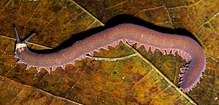The velvet worms (Onychophora — literally "claw bearers") are a minor panarthropod phylum.
| Velvet worms | |
|---|---|

| |
| A member of the Peripatidae family | |
| Scientific classification | |
| Kingdom: | |
| Superphylum: | |
| (unranked): | |
| Phylum: | Onychophora
|
There are two families and about 200 species. All living species live on land, in moist or wet tropical areas.
The two living families are the Peripatidae and the Peripatopsidae. They show a peculiar distribution, with the peripatids being mainly equatorial and tropical, while the peripatopsids are all found in what used to be Gondwana.[1]
The segmented worm-like organisms have tiny eyes, "fur", antennae, multiple pairs of legs, and, slime glands. The group is thought to be related to arthropods. They prey on smaller animals such as insects, which they catch by squirting a sticky slime.
Possible fossil history
changeFossils from the early Cambrian bear a striking resemblance to the velvet worms. These fossils, known as the lobopods, were marine. They were a clade from which arthropods, tardigrades, and Onychophora arose.[2][3] They are found in the Cambrian,[4] Ordovician (possibly),[5] Silurian,[6] and Pennsylvanian[7] periods.
Historically, all fossil Onychophora and lobopods were lumped into the taxon Xenusia. However, few of the Cambrian fossils have features that definitely unite them with the Onychophora.[8] The exceptions are Hallucigenia and Collinsium ciliosum, which have distinctly onychophoran-like claws.[2]
References
change- ↑ Piper, Ross 2007. Extraordinary animals: an encyclopedia of curious and unusual animals. Greenwood Press.
- ↑ 2.0 2.1 Smith M.R. & Ortega Hernández J. 2014 (2014). "Hallucigenia's onychophoran-like claws and the case for Tactopoda". Nature. 514 (7522): 363–366. Bibcode:2014Natur.514..363S. doi:10.1038/nature13576. PMID 25132546. S2CID 205239797.
{{cite journal}}: CS1 maint: numeric names: authors list (link) - ↑ Budd, Graham E. 2001 (2001). "Why are arthropods segmented?". Evolution & Development. 3 (5): 332–42. doi:10.1046/j.1525-142X.2001.01041.x. PMID 11710765. S2CID 37935884.
{{cite journal}}: CS1 maint: numeric names: authors list (link) - ↑ Bergström, Jan; Houb, Xian-Guang (2001). "Cambrian Onychophora or Xenusians". Zoologischer Anzeiger. 240 (3–4): 237–45. doi:10.1078/0044-5231-00031.
- ↑ Van Roy, Peter (2010). "Ordovician faunas of Burgess Shale type". Nature. 465 (7295): 215–8. Bibcode:2010Natur.465..215V. doi:10.1038/nature09038. PMID 20463737. S2CID 4313285.
- ↑ von Bitter, Peter H. et al 2007 (2007). "Eramosa lagerstätte—exceptionally preserved soft-bodied biotas with shallow-marine shelly and bioturbating organisms (Silurian, Ontario, Canada)". Geology. 35 (10): 879–82. Bibcode:2007Geo....35..879V. doi:10.1130/G23894A.1.
{{cite journal}}: CS1 maint: numeric names: authors list (link) - ↑ Thompson, Ida; Jones, Douglas S. (1980). "A possible Onychophoran from the Middle Pennsylvanian Mazon Creek beds of northern Illinois". Journal of Paleontology. 54 (3): 588–96. JSTOR 1304204.
- ↑ Budd, Graham E. 2001 (2001). "Tardigrades as 'stem-group arthropods': the evidence from the Cambrian fauna". Zoologischer Anzeiger. 240 (3–4): 265–79. doi:10.1078/0044-5231-00034.
{{cite journal}}: CS1 maint: numeric names: authors list (link)